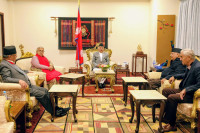Opinion
A modest proposal
Any design for federalism must ensure rightful shares for deprived groups in the power structure
Amar Kant Jha
Federalism has become so highly politicised that its solution is proving elusive. The issue has become complex primarily because our leaders have forgotten the spirit and letter of the pledge they made to the people during Janaandolan II. We must recollect the solemn promise the leaders of the then Seven Party Alliance expressed in the historic six-point agreement where they acknowledged their “failings in bringing about socio-economic transformation among women, ethnic groups, Dalits, Madhesis, people of backward regions, the poor and the suppressed” and committed themselves not to repeat past mistakes. In the same document, the leaders further vowed to adopt “a justifiable reservation system” for the deprived groups and to “restructure the state, reflecting social, cultural, geographical, ethnic, and linguistic diversities” in order to make representative democracy more inclusive and participatory. Trusting in these words, the masses propelled the peaceful revolution to an unprecedented height but unfortunately, these same leaders seem to have backtracked from their avowed promises.
Big Three proposals
Recently, the Nepali Congress (NC) and CPN-UML floated a common federalism model of seven provinces, which needs to be assessed from the perspective of the deprived groups’ share of the pie. In view of demographics, the hill high castes’ population in Koshi, Lumbini, Gandaki, Karnali, and the Far West provinces is larger, and thus, their hegemony in these states will persist. Though the hill high castes’ population in Bagmati is lower, being the ruling elites, their dominance will continue unhindered even in this province. In the Janakpur province, the Tarai-Madhesis will enjoy unrivalled authority, but in the rest of the Tarai, which is conjoined with the hills, they will be shorn of power. In fact, this federal model has been carved erroneously against the principle of federalism, ruining the geographical homogeneity of the Tarai, adversely affecting both the Tarai-Madhesis and other ethnic groups. This federal model cannot be acceptable to 61.8 percent of the population belonging to marginalised groups and can only provoke conflict.
Similarly, the UCPN (Maoist) has postulated 11 provinces in its election manifesto—three in the Tarai and eight in the hills based on single ethnic identity. The bases for such a proposal are ethnic and regional disparities, ignoring linguistic diversity as a basis for federalism. Language is universally acknowledged as the most important criterion for federating a country and in the Tarai, provinces based on language are the most viable, which can help Tarai-Madhesis gain access to the power structure.
Mistaken Madhyadesh
The Madhes-based parties too posit the entire Madhes as one province based on identity and in case of consensus, they can agree on two provinces in the Tarai. Here, the firm stand these parties hold on identity needs appraisal. They have a strong assumption that the ‘Madhes’ is a distorted term for Madhyadesh, which has a glorious history. But in fact, Madhyadesh, a central part of Aryavarta, had its established geographical boundary lying between the foot of the Himalayas and Vindhya Parvat from north to south and between Delhi and Allahabad from west to east. This demarcates the territory from Kapilvastu westwards as falling under Madhyadesh and eastwards of Rupandehi as falling outside this boundary. So, the entire Tarai cannot be identified as the Madhes. A different interpretation regarding the boundary of Madhyadesh, extending from Delhi to Bhagalpur, is cited from a Buddhist scripture but since no historical or other evidence has been found to support this claim, the entire Madhes as one province based on mistaken identity is untenable.
In reality, it was the Shah dynasty and the Ranas who addressed the exploited denizens of the Tarai as ‘Madhesis’. As ‘Nepal’ meant only the Kathmandu Valley for millennia, it later came to denote a nation made up of all the vanquished parts of the Tarai and the hills under Prithvi Narayan Shah’s unification campaign. In the same way, the south-western region of the Tarai—a part of the Madhyadesh that used to be called ‘Madhes’ by the Gorkhas—later got its meaning extended to denote even the eastern Tarai after unification. Therefore, associating the entire Tarai with the identity of Madhyadesh is fictitious.
An eight-state proposal
Coming back to federalism, in the initial stages, it would be proper to federate the country into fewer states so that they can be economically sustainable. Therefore, eight states have been posited—four in the Tarai-Madhes based on dual linguistics and four in the hills, based on dual ethnic diversities, encouraging all sizable groups, including the hill high castes, Janajati groups and Tarai-Madhesis, to have a proportional share in the power structure.
Their brief delineations are thus. Mithila state from Saptari to Simraungadh of Bara with Janakpur as its capital and Nepali, Maithili (2,391,020 speakers) and Bajjika (791,217 speakers) as official languages. Bhojpura state from Bara (except Simraungadh) to Rupandehi, including Ayoudhyapuri, Kalyanpur, Bagauda, and Gardi and some of the south-western part of Chitwan National Park, integrating the Bhojpuri-speaking region, with Birgunj as its capital and Nepali, Bhojpuri (1,474,802 speakers) and Middle Tharu (202,840 speakers) as official languages. Tharuwan/Awadhi-Tharuwan state from Kapilvastu to Kanchanpur, with Nepalgunj as the capital and Nepali, Western Tharu (945,166 speakers) and Awadhi (441,910 speakers) as official languages. Birat state based on mixed criterion from Jhapa to Sunsari with Biratnagar as capital and Nepali, Maithili (489,057 speakers) and Eastern Tharu (152,742 speakers) as official languages.
Similarly, Limbu-Kirat state of 11 eastern hilly districts with Dhankuta as capital and Nepali, Rai (440,918 speakers) and Limbu (230,418 speakers) as official languages. Newa-Tamang state of 13 districts from Sindhuli, Ramechhap to Nuwakot and Chitwan with Kathmandu as capital and Nepali, Newari/Nepal Bhasa (480,027 speakers) and Tamang (1,112,822 speakers) as official languages. Tamu-Magarat state of 17 districts from Gorkha, Lamjung to Rukum and Salyan with Pokhara as capital and Nepali, Magar (296,247 speakers) and Gurung (207,201 speakers) as official languages. Finally, Khas state of 13 western hilly districts with Surkhet as capital and Nepali, Doteli (787,827 speakers) and Baitedili (272,524 speakers) as official languages.
Ethnicity as basis
The idea of ethnic federalism is often sharply rebuffed on the argument that the population of Janajati groups is not dominant in their respective regions. But examples from India, where eight states are based on ethnicity, can provide useful inputs. The population of various ethnic groups is 86, 89, 94, and 65 percent respectively in Meghalaya, Nagaland, Mizoram, and Arunachal while it is 31, 32, 39, and 26 percent respectively in Tripura, Chhatisgadh, Manipur, and Jharkhand. Compared to them, the population of various Janajati groups in Nepal would be 44.7, 53.8, and 40.3 percent respectively in the proposed Limbu-Kirat, Newa-Tamang, and Tamu/Magarat with the Rais, Tamangs, and Magars are in a majority in their respective states. Even the Limbus, Newars, and Magars will be in large numbers in the regions that they regard as their homelands. These ethnic groups have their own history and identity, which are jeopardised by threats to their language—74.3 percent Rais, 58 percent Magars, 37.7 percent Gurungs, and 35.9 percent Newars, together with a very high percentage of other Janajati groups, have abandoned their language. Hence, the formation of these states are justifiable also for social justice.
Federalism will be useful only when it ensures that deprived groups get due shares in the power structure. If states are carved purposelessly, people’s aspirations will never be met and the remedy will be worse than the malady. Here, a proposal of eight states based on dual identity, reflecting linguistic and ethnic diversities, has been put forward. Such a federal structure can eliminate discrimination and accommodate deprived groups in power-sharing, effecting unity in diversity and strengthening both democracy and nationalism.
Jha is a retired professor from Rajbiraj




 13.12°C Kathmandu
13.12°C Kathmandu











